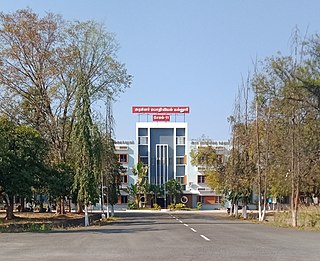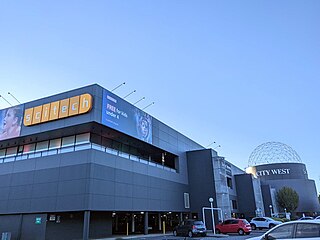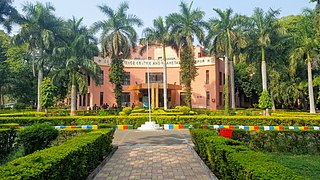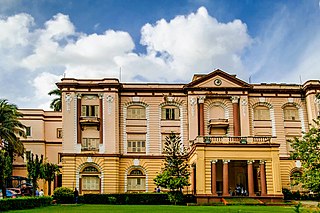
A planetarium is a theatre built primarily for presenting educational and entertaining shows about astronomy and the night sky, or for training in celestial navigation.
Nehru Planetariums are the five planetariums in India, named after India's first Prime Minister, Jawaharlal Nehru. These are located in Mumbai, New Delhi, Pune and Bangalore, plus there is a Jawahar Planetarium in Allahabad, where Jawaharlal Nehru was born.

Kuppam is a City in Chittoor district of the Indian state of Andhra Pradesh. It is located 115.8 kilometers south-east of Bangalore, the capital city of Karnataka, and 243 kilometers west of Chennai, the capital of Tamil Nadu. It is the headquarters of Kuppam mandal in the Kuppam Revenue Division. The name "Kuppam" means a meeting place or confluence.
Perambur is a neighbourhood located in the northern region of Chennai, Tamil Nadu, India.

The Government College of Engineering, Salem in Salem, Tamil Nadu, India, is an engineering education center in the state of Tamil Nadu. It is one of the three institutions offering Metallurgical Engineering as a full-time course in Tamil Nadu.
Guduvancheri is a suburb located to the south of Chennai city, Tamil Nadu, India. It has a railway station on the Chennai Beach–Chengalpattu section of the Chennai Suburban Railway Network and is a municipality in Chengalpattu district, Tamil Nadu, India. It is also part of the Vandalur taluk and lies in the southern part of Chennai metropolitan area. It has a lake known as the Guduvancheri lake and Nandivaram lake. It serves as the connecting hub between Chennai and Chengalpattu. It also lies on the major highway connecting Chennai with Kanyakumari, the southernmost point of the state and the country. Guduvanchery, despite its peripheral location in Chennai, has seen substantial development in social infrastructure. It is located approximately 40 kilometers from the city center at Parry's Corner, along the Grand Southern Trunk Road.

Scitech is a not-for-profit company encompassing the Scitech Discovery Centre, an interactive science centre in West Perth, Western Australia, outreach programs, professional learning programs and digital content.

Chennai Book Fair is an annual book fair organized in Chennai, India by the Booksellers and Publishers Association of South India (BAPASI). The fair typically lasts for about two weeks during the New Year-Pongal season, that is between the last week of December and the third week of January. It is the second largest book fair in the country after the Kolkata Book Fair. All major Tamil and English publishing houses participate in this fair. It is considered an important event in the Chennai cultural calendar along with the Chennai music season.

The Raman Science Centre and Raman Planetarium Complex at Nagpur is an interactive science centre affiliated with Mumbai's Nehru Science Centre. The centre was developed to promote a scientific attitude, portray the growth of science and technology and their applications in industry and human welfare, and hold science exhibits. The centre is named after famous Nobel Prize winner Indian physicist Chandrasekhara Venkata Raman.

Birla Industrial & Technological Museum (BITM) is a science museum in Kolkata, West Bengal, India. It is a unit under National Council of Science Museums (NCSM), Ministry of Culture, Government of India. Initially under the governmental jurisdiction of the Council of Scientific & Industrial Research (CSIR), BITM is commonly recognized as the precursor of India's science museum concept.

B. M. Birla Planetarium is a large planetarium in Chennai, India. The fifth B. M. Birla planetarium in the country, it is located at Kotturpuram in the Periyar Science and Technology Centre campus which houses eight galleries, namely, Physical Science, Electronics and Communication, Energy, Life Science, Innovation, Transport, International Dolls and Children and Materials Science, with over 500 exhibits. Built in 1988 in the memory of the great industrialist and visionary of India B. M. Birla, it is considered the most modern planetarium in India, providing a virtual tour of the night sky and holding cosmic shows on a specially perforated hemispherical aluminium inner dome. Other Birla planetariums in India include the M. P. Birla Planetarium in Kolkata, the Birla Planetarium in Hyderabad, and the planetariums in Tiruchirapalli and Coimbatore.

B. M. Birla Science Museum is an Indian science museum located in Hyderabad, India. Constructed by civil engineer P. A. Singaravelu, it comprises a planetarium, museum, science centre, art gallery as well as a dinosaurium. The museum itself was the second phase of the science centre when it opened in 1990. The centre also houses India's first private Space Museum. The museum is a unique facility which is dedicated to history of the space program of India. The space museum was inaugurated in July 2019 and was curated by Pranav Sharma.

The Birla Planetarium in Kolkata, West Bengal, India, is a single-storeyed circular structure designed in the typical Indian style, whose architecture is loosely styled on the Buddhist Stupa at Sanchi. Situated at Chowringhee Road adjacent to the Victoria Memorial, St. Paul's Cathedral and the Maidan in Central Kolkata, it is the largest planetarium in Asia and the second largest planetarium in the world. There are two other Birla Planetariums in India: B.M. Birla Planetarium in Chennai and the Birla Planetarium in Hyderabad.

Anna Science Centre is established for the cause of educating young generation and general public on the objectives of Tamil Nadu Science and Technology Centre. The Centre hosts Science and Technology Halls with various exhibitions and also a planetarium.

The Department of Higher Education is one of the departments of Government of Tamil Nadu. Established in 1997, the department is responsible for formulating policies and regulations for higher education in the state.

Swami Vivekananda Planetarium, also called Pilikula Planetarium, at Pilikula Nisargadhama in Mangalore is the first 3D planetarium in India. It is also only such planetarium in the country with hybrid modern technology innovations coupled with 3D technology of 8K digital and opto-mechanical (hybrid) projection system. It is a part of the Pilikula Nisargadhama, which is also named Dr Shivaram Karanth Biological Park. It is planned and built to provide the best learning experience for students and enthusiasts on Zodiacal system of planets. Its creation is attributed to Pilikula Regional Science Centre.
Salem Science Park is an research and development facility located in Pallapatti, Salem, Tamil Nadu, India. Established for scientific research, the park is home to a planetarium, 80 science models and an innovation hub for students.














